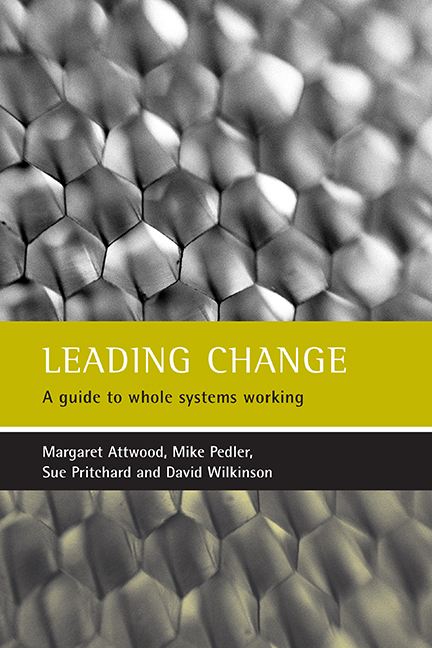Book contents
- Frontmatter
- Contents
- Foreword
- Foreword
- Prologue
- one Why do we need whole systems change?
- Two How Do We Put These Fine Words Intoaction? An Overview of Whole Systems Development
- Three The emerging practice of wholesystems development
- Four Leadership: keeping the big picture in view
- Five Public learning
- Six Valuing difference and diversity: getting the whole systeminto the room
- Seven Meeting differently: large and small group working
- Eight Follow-through and sticking with it
- Nine From organisations to networks
- Ten Confirming cases: local problems andlocal solutions within whole systems
- Epilogue
- Bibliography
- Index
Three - The emerging practice of wholesystems development
Published online by Cambridge University Press: 20 January 2022
- Frontmatter
- Contents
- Foreword
- Foreword
- Prologue
- one Why do we need whole systems change?
- Two How Do We Put These Fine Words Intoaction? An Overview of Whole Systems Development
- Three The emerging practice of wholesystems development
- Four Leadership: keeping the big picture in view
- Five Public learning
- Six Valuing difference and diversity: getting the whole systeminto the room
- Seven Meeting differently: large and small group working
- Eight Follow-through and sticking with it
- Nine From organisations to networks
- Ten Confirming cases: local problems andlocal solutions within whole systems
- Epilogue
- Bibliography
- Index
Summary
As indicated in the values statement in the Prologue, whole systems development aims to help people get things done locally. Because it is focused on local implementation rather than on dramatic intervention, whole systems development is not a neat, predictable process. Typically drawn in by a person or an organisation with a question, it starts from the problem and develops a change methodology in partnership with people in that setting. The principles that guide the work emerge as ‘grounded theory’ in particular contexts.
Nevertheless, a broad framework or ‘change architecture’ (see Chapter Eight) for such processes can be described. This framework has three components: context, content and process. Whole systems development operates within a context of change described by such dilemmas as those discussed in Chapter One – top-down and bottom-up, consumer and citizen, treatment and prevention, and consultation and participation. Within this context, the content or focus of the work is defined by the Five Keys of whole systems development, while the process is governed by some important principles of practice (see Chapter Two, pages 28-9).
In this chapter, through the case study of a courageous effort to deconstruct the old system of local government and challenge it with a structure based onresident self-governance through neighbourhood committees, we:
• illustrate the main principles and themes of whole systems development as they emerge from practice;
• demonstrate that all whole systems development activities are a process of action learning;
• develop a number of other themes and principles through the emergingstory of Gladwell – working via ‘widening circles of inclusivity’ withinmultiple, overlapping systems, using action learning in the whole systemscontext, creating the space for leadership via ‘holding frameworks’ and ‘middle-ground frameworks’. (These ideas are developed in more depth in the lastthree chapters.)
The story that emerges is more an account of our learning, than a cause–effect change intervention of what we did. This implies starting by trying something, reflecting and learning from it, and expecting to be confounded from time totime. It is vital to keep struggling to make sense, to learn, to act and to contribute.
We have also learned that it is not easy to keep hold of values and principles change of practice where people have a natural expectation that they employ you totell them what to do.
- Type
- Chapter
- Information
- Leading ChangeA Guide to Whole Systems Working, pp. 39 - 56Publisher: Bristol University PressPrint publication year: 2003



